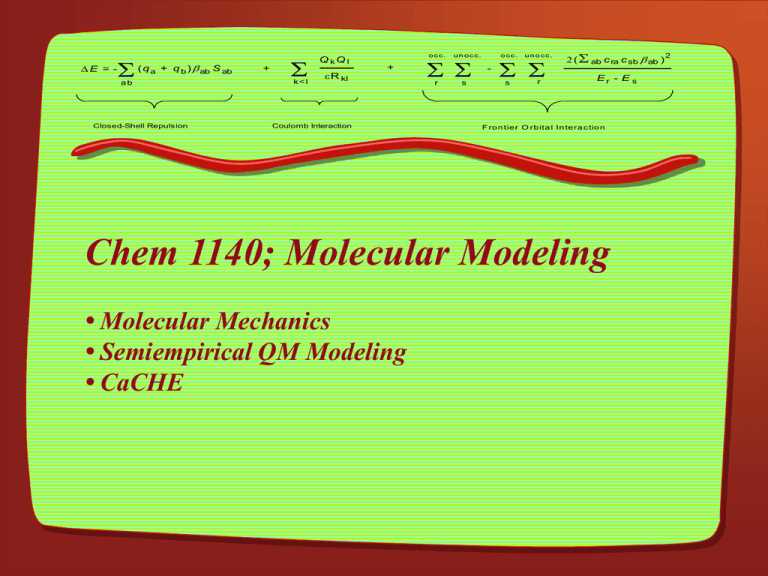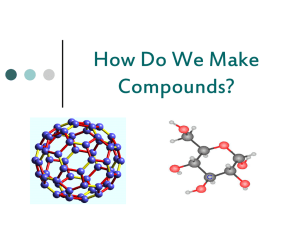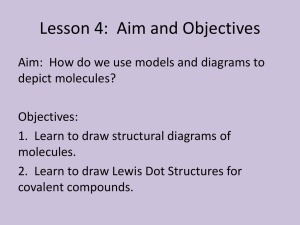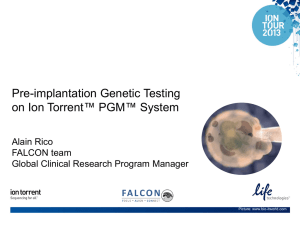Molecular Modeling.p..
advertisement

E = - ( q a + q b ) ab S ab ab Closed-Shell Repuls ion + k<l Q kQ l R kl oc c. + Coulomb Interaction un oc c. r s o cc . - u no cc . ( ab c ra c sb ab ) r Er - E s s F ro n tie r O rb ita l In te ra c tio n Chem 1140; Molecular Modeling • Molecular Mechanics • Semiempirical QM Modeling • CaCHE 2 A. Modeling Software Overview: http://cmm.info.nih.gov/software.html - CaCHe: Structure building. Extended MM2(87) energy minimization, extended Hückel, MOPAC, ZINDO MO programs. Orbital electron density and electrostatic maps. Prediction of octanol/water partition coefficient and water solubility B. Introduction to Molecular Modeling Objectives: - Computer graphics visualization of molecules ("Dreiding models") - Matching (overlays, docking) of molecules - Use of empirical force-fields to determine molecular properties as well as interatomic distances. - Correlate molecular properties with an electronic structure from ab initio quantum mechanics or semiempirical quantum mechanics. - Gain information on dynamic molecular movements. - Use computer-assisted design for molecular recognition in organic, bioorganic, and medicinal chemistry and material science. Sc hem at ic of m olec u lar force field express ion. D iagonal ter m s re fer to in teract ion s that ca n be expresse d as fun ct ions of a singl e in ter nal co o rd in ate, w hereas cross ter m s in trod uce co upled in ter a ct ions inv olving tw o or m ore coord in ates. B ond stretc h: D ih edra l pote nti als T h e trad iti o nal e xpress ion fo r th e dih edra l pote ntial e n er gy is a cos in e ser ies : Computational Options Si n gle po in t calc u la ti on . T h e ener gy of th e sy ste m at a spec ifi ed co nfigu rat ion . In lo c al m eth o ds for find ing a m inim um effo rt is dir e cted tow a rd a n ea rby loca l min imu m , a nd st e ps tha t may inc re a se the fu ncti o n a re not pe rm itted. Descen t s truct u re o f loca l m inimi z ati o n algor ith ms: T h e lo cal mi ni ma pr o blem T h e searc h fo r th e gl obal m ini m u m 1 Ge nera lly , we are m ost in te rested in the p referred (m ost stab le ) co n form at ion o f ou r m o lec ul es a nd t h e c onfo rm ers w hi ch are s igni fica ntly p o p ul ated at r oo m te m perat u re (w ithin ap p ro x . 3 kca l/m ol o f th e gl ob al m in im um ). A nu m ber o f co n fo rm at io nal searc h tec hni que s h ave bee n de v eloped to answer th ese q u estio n s. Str uct u res o f loca l a n d gl oba l m in im izat io n a lg or ith m s: 1 Sau n ders, M. et al. J. A m. C he m. So c. 1 9 9 0 , 1 1 2 , 14 1 9 - Gr id searc h ; Fo r ver y sim ple str uct u re s, thi s ca n be do ne m anu ally . (MM2/3 : angl e dr iv er to creat e reaso n ab le start ing g eo m etries for co nfo rm at ion al searc hing ). H H H H H H H H H H T hi s syste m at ic proced u re p ro vi des gua ran teed co vera ge of all re g io n s o f space if a suffi cient nu m ber o f start ing po in ts is se lected (at least 3 per dihedr al a ngl e). Prob le m s: an extrao rdin ar y la rge nu m be r of start ing str uc tures i s g enerated, w hi ch re n ders t h e prob lem ve ry co m p u te r-tim e in te nsiv e, espec ially for flexi b le str uct u res. F or ex am ple, for p oly pe p tides of n res idu es, a ro ug h ra ng e of 10 n to 25 n reaso n ab le start in g po in ts by coarse su bdo m ain part itio n of back b o ne and sidec hain s hav e to be inv est ig ated. If th e n u m ber o f valu es o f fo r eac h to rs ion is red uced, th e reso luti on w ith w hi ch sp ace is co v ered m ay b e in adeq u ate to pro vi de a start ing g eo m etr y in the vi cin ity o f eac h m ini mum . Newer m o lec ul ar m od eling packa g es off er se v era l force fi elds. C h oose w ise ly ! MM 2: Or g ani c m o lec ul es. L ast re lease : 1987. 1 MM 3: Or gani c m o lec ul es. L ast re lease : 1 994 (Th e MM3 * o n Macro m o de l is th e MM3/91 re lease an d is li m ited to f ew e r fun ct ion ali ties). A M BER : Prote in s and nu cleic ac ids, carbo hy drates. 2 O P L S : Pept ides. T h e uni ted -ato m s im ul ation treats certa in ato m g ro u ps as o n e ato m , w ith o ne ato m type. 3 BIO+ : (C HA RMM) Bi o lo gi ca l m acr o m o le cul es . 4 1 All ing e r, N. L. et al. J. A m. Ch e m. S o c. 1 9 9 2 , 1 1 4 , 1. 2 K o llm a n, P. A. et al. J. Com p. C he m. 1 9 86 , 7 , 2 3 0 . 3 Jorg e ns e n, W. L. et al. J. A m. C h e m. S o c. 1 9 91 , 1 13 , 2 8 10. 4 K ar p lus, M. et al. J. C om p. C h e m. 1 9 8 3 , 4 , 1 8 7. C. Semiempirical Methods Molecular mechanics methods are based on classical concepts and require computer time roughly proportional to the square of the number of atoms. In contrast, semiempirical methods at the Hartree-Fock level use a combination of quantum chemical models and experimentally determined parameters to strive for accuracy and scale up as (4N)3. Finally, ab initio quantum mechanics proceeds as (10N)4 (for glucose: 1:1,500:6,000,000). There are important differences between classical molecular mechanics and quantum mechanical methods. MM methods are extremely fast and able to handle very large systems. Particularly for hydrocarbons, they are also as accurate as the best ab initio methods. But they are only parametrized for ground state systems and common bonding situations (functional groups). MM methods are unable to anticipate the making and breaking of most bonds, the electronic properties of molecules, and the chemistry of electronically excited states. Use molecular orbital methods to compute: - bond orders - dipole moments - ionization potentials - vibrational frequencies and IR, UV spectra - MO energies - partial charges - potential energy maps - reaction pathways - transition states - heats of formation - mapping bond breaking and bond formation The transition between semiempirical and ab initio quantum chemistry is not always obvious. Basis sets, for example, are empirical in nature, as are effective core potentials. T h e in te rm ed iat e n eg lect of d iffe re ntial o v er lap ( IND O ) sc h em es keep all o f th e o ne -ce n ter te rm s abo ve: INDO /S 1 (spectroscop MINDO/3 y o f tra nsiti on m eta l co m p lex es; it was u se d o n th e react io n ce nter o f p h otos yn th et ic bacter ia). was de veloped in 1975 to re pr od u ce su ch d iv ers e ex per im en ta l pr o pert ies as m olec ul ar g eo m et ri es, h eats o f fo rm at ion , d ipo le m om ents, an d io ni zat io n p o te n tials. All q uan tities in th e F ock m atrix an d th e en er g y ex press io n were treated as free para m eters, an d th e reso nan ce in te g ra l was ch ose n to b e a pa ir para m eter rat her th an the av era g e o f two ato m ic para m eters. H , B, C , N, O , F , S i, P, S , a nd C l are para m etr ized. MNDO, 1 A M1, 2 and PM3 3 are a ll NDDO te chni q u es de v eloped b y Dewar an d h is coworkers an d u se esse ntiall y all th e sa m e m ode l fun ct io ns. MNDO h as bee n para m et ri zed fo r H , Li , B , C, N, O, F , Al , S i, P, S, C l, Z n , Ge, B r, S n , I, Hg , and Pb. It u ses m o n oato m ic par a m eters a n d i s co m p utat io n ally qui te effi cien t bu t fail ed fo r b io logi ca lly in terest in g m o lec u les. A M1 has bee n par a m etr ize d fo r H , B , C, N, O, F , Al , S i, P, S, C l, Z n, Ge, B r, I, and Hg , an d PM3 for H , B e, C , N , O , F , M g , Al , S i, P, S, C l, Z n , G a, G e, A s, Se , B r, Cd , In , S n , Sb, Te, I, Hg , T l, Pb, an d B i (t h e th ird - an d fo u rt h -row m ain -gro up elem en ts h av e o nly rece n tly bee n add e d). P M3 an d A M1 u se a differe n t eq uat io n fo r t h e core -core re pul sion te rm ( thi s is a prob lem f or A M1 w ith P, Al , a n d N). PM3 d that th e fo rm er treats th e o n e-ce n te r, two -el ectro n in te g ra ls as p ure para m eters, as opposed ato m ic spectroscop iffe rs fro m A M1 in to be ing der iv ed fro m y. S parta n Õs PM3( tm ) m ode l i s para m etrized for T i, Z r, Hf , Ta, Cr, Mo, W, Co, R h , N i, a nd Pd , u sed in co n jun ct ion w ith PM3 fo r n o n-tra nsi tio n m eta ls. A M1 : - see m s to be m ost acc urate for ca lcul at ion s of dipo le m o m ents fo r elem ents that it has bee n para m etr ize d for. - reprod uces hy drogen-bon ds sligh tly bette r a nd - giv es ener gi es that are st ill too lar ge for act iv at ion ba rriers. - reprod uces gro u nd-state geo m etries qui te acc urate ly . - is poor in reprod ucing lon-pai r lon-pa ir re pul sion. - has an a vera ge error of heats of for m at io n of C, H , N , O co m po un ds of ca. 40%. 1 D ew ar, M. J. S. et al. J. Co m p. C h e m. 1 9 8 1 , 2 , 4 3 3. 2 Austin M od e l 1; D ew ar, M. J. S. et al. J. C o mp. Che m. 19 8 1 , 2 , 4 3 3. 3 Pa ra metri c Met h o d Nu m b er 3. St ew art, J. J. P. J. C om put. C he m. 1 9 8 9 , 1 0 , 2 2 1. Th is re p res e nts the t hir d p a ra metri z atio n of MN DO (AM 1 b e ing th e sec o nd). C h aracter izat io n s o f the wa v e fun ct ion In a se mi -em p irica l ca lcu lat io n, th e en ergy , the first de riv at ives o f th e ene rgy an d th e wa ve fun cti on fo r th e m o lec ul e are co m p uted. Ot he r m o lec ula r proper ti es are bas ica lly an av era g e o v er th e wa v e fun ct ion o f ce rta in operators descr ib in g th e proper ti es. A m o ng th e vi su ali zab le prop e rt ies that are g enera lly co m p u ted are : Tota l e lectro n de n sity represe nts th e proba bili ty o f a n e lectro n be ing at a part icula r po in t in space. Sp in de nsity d efin es th e ex cess probab ility of fi n d ing sp in -u p o ve r sp in -d o w n elec tro ns at a po in t in space. T he sp in de n sity at th e pos itio n o f a nu cleus is th e a pr im e deter m in an t o f ESR spectra. Orb ita l pl ots are u sed to vi su ali ze m olecul ar or bi ta ls, espec ially fro n tier o rb ita ls, for th e analy sis of or g an ic react io ns. E lectrosta ti c pote n tials ca n be used to p red ict in itial attack pos iti o n s of ion s d u ring a react io n. T he p ote n tial o f a pos itiv e p robe cha rg e is ca lcul ated as a fun ct ion o f th e di sta n ce to th e m o lec ul e, th e nu clea r ch ar ge, and th e electro ni c de nsity . A to m ic part ial c h arg es giv e a cr u de idea for th e distr ib u tio n o f c h ar g es in a m olec ul e. IR, UV/VIS absorpt io n spectra. Kondru, R. K.; Wipf, P.; Beratan, D. N., "Theory assisted determination of absolute stereochemistry for complex natural products via computation of molar rotation angles." J. Am. Chem. Soc. 1998, 120, 2204-2205. Wipf, P.; Kerekes, A. D., "Structure reassignment of the fungal metabolite TAEMC161 as the phytotoxin viridiol." Journal of Natural Products 2003, 66, 716-718.







